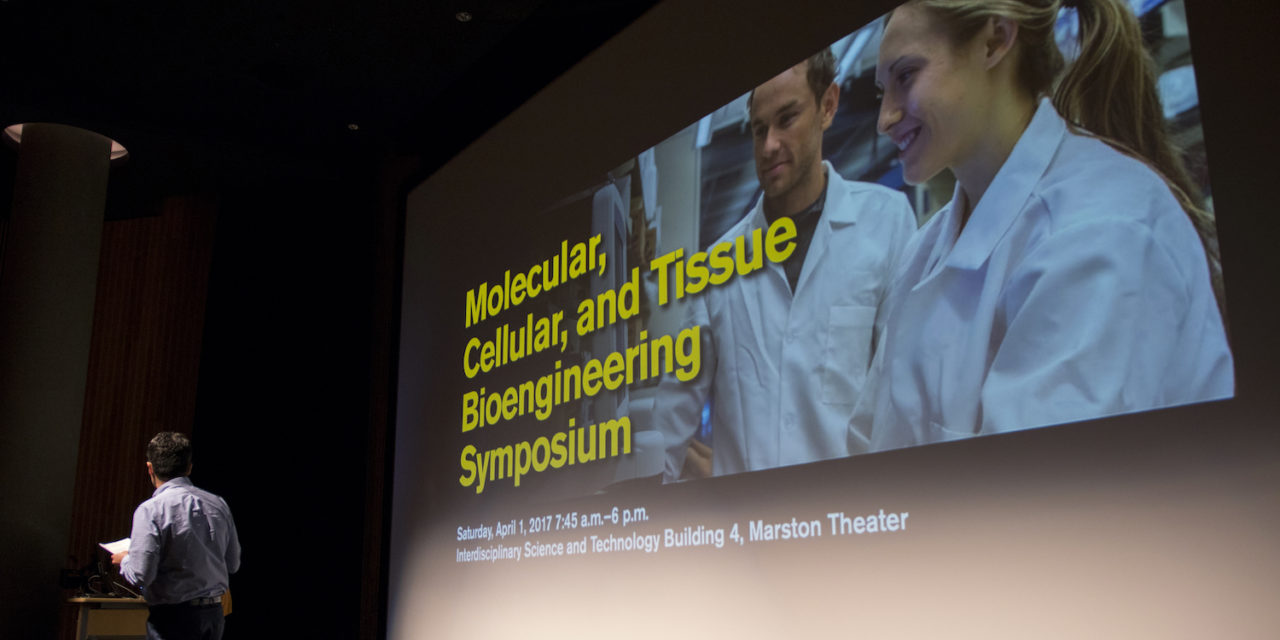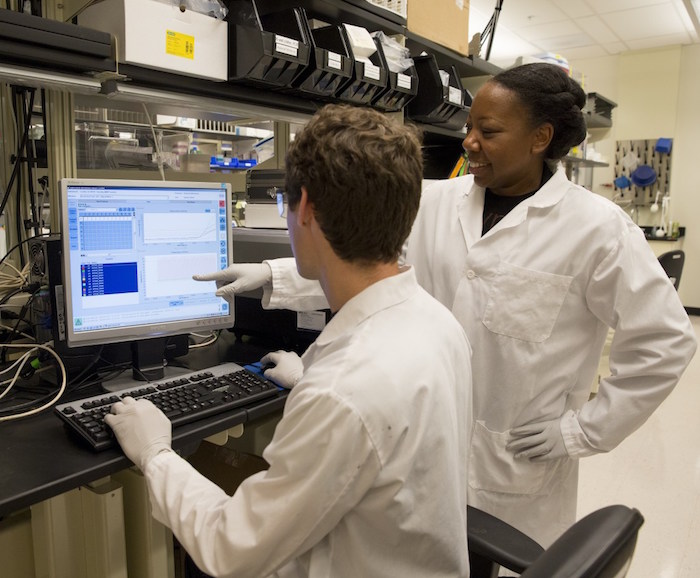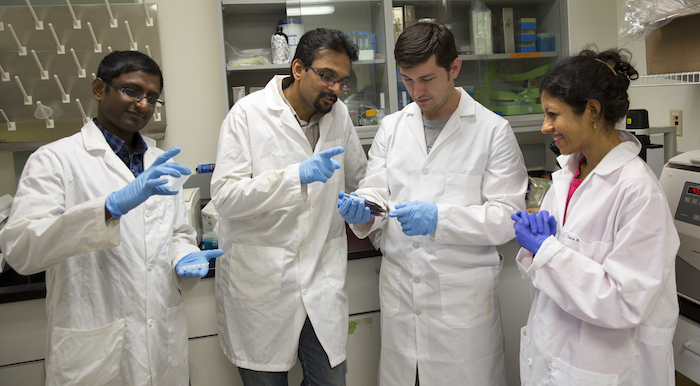
‘Soft’ side of bioengineering poised to make big impacts

Arizona researchers, educators, students and representatives of industry, government agencies and health care institutions gathered at the annual ASU Molecular, Cellular and Tissue Bioengineering Symposium in 2016 and 2017 to discuss the potential these fields hold for sparking medical advances. Photographer: Marco-Alexia Chaira/ASU
There are more technically precise descriptions of what’s at the core of a growing trend broadening the horizons of biomedical engineering than “the soft, squishy side of bioengineering.”
But Karmella Haynes and Kaushal Rege still like the way that sums up what they and about 20 other Arizona State University faculty members are increasingly focusing on in their research and teaching.
The main thrust of biomedical engineering has long involved the hardware that the field produces — devices, tools, machines, electronics and prosthetic apparatuses.
Now the spotlight is rapidly being shared by engineers and scientists who are seeking to solve medical challenges through their increasing ability to manipulate cells, molecules, genes, proteins and neural systems — those so-called “soft,” pliant and sometimes living biomaterials.
So, about four years ago, “it really started to make sense to form a group to strategize about how we could grow this area at ASU,” both in the labs and the classrooms, says Haynes, a synthetic biologist and assistant professor of biomedical engineering in ASU’s Ira A. Fulton Schools of Engineering.
“We needed to start connecting with each other, to share knowledge and to collaborate to bring these new things happening in the biomedical field to the forefront here,” says Rege, a professor of chemical engineering in the Fulton Schools.
An array of new bioengineering capabilities

Assistant Professor Karmella Haynes (right) says a stronger emphasis on educating students about the biological side of biomedical engineering can broaden their skills and boost their career prospects. Photographer: Jessica Hochreiter/ASU
The Molecular, Cellular and Tissue Bioengineering Group made its public debut of sorts with the inaugural Molecular, Cellular and Tissue Bioengineering Symposium at ASU in 2016, followed by a second symposium last spring that drew almost 150 participants, nearly doubling attendance at the first event.
The gatherings included not only university faculty and graduate students from across Arizona but also representatives from industry and state health agencies.
Audiences saw presentations and heard talks about an expanding array of biomedical techniques being developed that hold promise for treating diseases, healing damaged organs and alleviating various disorders.
There are therapeutic gene editing and DNA sequencing techniques being developed with the aim of curing disease.
Researchers are exploring the use of certain proteins produced by our bodies to treat diseases — proteins that could potentially be more effective than the chemical compounds in the drugs that are now widely used.
“With our ability to figure out how DNA is expressed and translated into a protein, we now have a much clearer picture of all the different types of coding sequences in DNA and the proteins that are produced by the body,” Haynes explains.
That capability, she says, “enables us to take a healthy cell and compare it to a diseased cell, and then say ‘This is what is right in the healthy cell and these are the things that are wrong in the unhealthy cell.’ Then we could introduce the right things into the diseased area to try to fix it.”
Rege’s research team is investigating other aspects of such regenerative medicine.
One project involves experimentation with efficiently delivering therapeutic molecules into cells that could target areas of disease.
Techniques like that could also be part of new processes to perform body tissue repair, helping to seal internal organs after surgical incisions — in conjunction with the use of laser light to activate sealing — and even healing organ tissues damaged by injury or disease.
Improving treatment of myriad diseases and damaged organs
Other Fulton Schools faculty members are doing work that demonstrates the myriad possibilities of applying new bioengineering skills to improve human health.
Assistant Professor Jeffrey La Belle’s team is developing implantable and wearable point-of-care sensing systems for disease diagnosis and management.
The technologies utilize “molecular recognition” of such things as enzymes, antibodies and DNA for sensing particular molecular targets that provide information about certain health conditions.
By sensing multiple biomarkers, the devices can help medical professionals better determine proper care by more accurately assessing patients’ conditions, La Belle says. They can be particularly effective in enabling people with diabetes, cardiovascular disease and abdominal organ transplants to monitor their health, and for improving evaluation of the status of trauma patients.
Associate Professor Xiao Wang is involved in the design and construction of gene circuits. That entails deeper understanding of the body’s complex gene-regulation networks and what triggers the cell differentiation process, by which stem cells transform into a range of specialized cells critical to the functioning of essential bodily systems.
The aim is to find ways to more effectively determine “cell fate,” Wang says. Controlling those transitions would make it possible to produce cells designed to help treat infections and diseases, and repair tissues and organs.
Achieving that could help reduce the need for transplants and improve therapies and treatments for spinal injuries and perhaps even Alzheimer’s Disease and blindness.

Professor Kaushal Rege (second from left) says the Molecular, Cellular and Technology Group will work to earn more support for research training programs for graduate and postdoctoral students. Photographer: Nora Skrodenis/ASU
Research can translate into big advances in clinical care
Associate Professor Sarah Stabenfeldt is focusing on new and improved therapeutics and diagnostics for brain injury, employing techniques springing from discoveries in molecular biology, neuroscience and materials science to develop and evaluate those diagnostic and treatment systems.
She is experimenting with the use of engineered nanobodies — therapeutic proteins derived from antibodies that contain structural and functional properties of naturally occurring antibodies.
The goal is to develop nanoparticle systems that can be introduced into the bloodstream as “targeting probes” that locate the molecular and cellular source of brain damage.
Those tiny probes would be able to recognize the complexity and severity of neural injury to the brain at the molecular level, thus providing more relevant information to guide treatment of traumatic brain injury, Stabenfeldt says.
Assistant Professor Rachael Sirianni is employing similar approaches to develop more effective treatments for cancer and other degenerative diseases.
Sirianni is an adjunct biomedical engineering faculty member with the Fulton Schools whose primary appointment is with the Barrow Neurological Institute at St. Joseph’s Hospital and Medical Center in Phoenix, where she runs an academic research program that includes joint ASU/BNI neuroscience endeavors.
She is exploring the use of biomaterials for targeted drug delivery. tissue engineering and medical imaging. She’s confident that work in these and related areas will eventually help bring about significant medical advances.
“The range of problems we can tackle and the knowledge we can gain through these emerging aspects of bioengineering will eventually lead to better therapeutics and a big overall impact on the future of clinical care,” she says.
Potential to benefit from cross-disciplinary collaborations
There are obstacles that must be overcome to achieve the scientific and engineering capabilities necessary to fulfill that promise, she adds, but she believes collaborations like those being fostered by the Molecular, Cellular and Tissue Bioengineering Group could speed progress.
Along with about a half-dozen other Fulton Schools faculty, colleagues in ASU’s School of Life Sciences, the School of Molecular Sciences and research specialists with the Biodesign Institute are also engaged in advancing knowledge in molecular, cell and tissue biology.
Much of that work has drawn support from the likes of the National Science Foundation, the National Institutes of Health, the ASU Foundation’s Women & Philanthropy program, the American Heart Association and the Arizona Biomedical Research Commission, which also provided $20,000 to help fund this year’s ASU Molecular, Cellular and Tissue Bioengineering Symposium.
The ABRC, a part of the Arizona Department of Health Services, sees significant benefits for the state in helping “to create a shared sense of community” among engineers, scientists, industries and healthcare institutions interested in making medical advances, says Jennifer Botsford, the commission’s program manager.
The faculty group has the potential to “create opportunities for cross-fertilization of ideas that push the boundaries of science,” says the vice president of research for ASU’s Knowledge Enterprise Development office, Betsy Cantwell.
Their work “is not only necessary, but genuinely innovative and inclusive, as demonstrated by their national stature and international connections,” Cantwell says.
Opening opportunities and career options for students
Such endorsements are motivating the group to put plans into action to more solidly establish its identity and pursue its long-range goals.
Haynes is hoping that by next year the symposium will start to become more of a regional event and draw prominent experts and industry leaders from throughout the Southwest.
She and Rege also hope to encourage more serious discussion with ASU leaders about ideas for a future lab complex or even a building where the university’s biomedical researchers could be headquartered.
“To optimize our resources and make full use of our talents, it’s important to have an environment that allows us to see and talk to each other about our individual work,” Rege says. “That is how ideas get generated and collaborations happen.”
On one front, the group’s aspirations are already taking shape.
The Fulton Schools biomedical engineering program is in the process of launching a new curriculum track that will make this “soft, squishy side” of the field more of an educational focal point at ASU.
“This is a huge deal,” Haynes says, “because we can offer more to students who want a stronger combination of medical education and engineering that’s going to open up their career possibilities.”
The group seeks to not only attract more funding for faculty research but also for research training programs for graduate students and postdoctoral students.
That would be a significant step toward elevating ASU among medical science and engineering education leaders.
Says Rege: “We want this to be a place where people can come to see and learn about and contribute to really big things happening in all these fields. That’s our vision.”



































